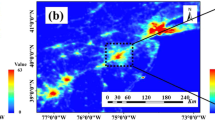Abstract
A new technique for estimating quiet day curve (QDC) was suggested. To validate the new approach, QDCs were derived from data acquired by the imaging riometer installed at the Chinese Zhongshan Station in Antarctic. The evaluation was performed by comparing the difference between QDC derived by the new technique and those derived by Tanaka’s technique. The results were discussed in terms of the diurnal variation and discrepancy. Also, cosmic noise absorption (CNA) images were built using both techniques in order to evaluate the implications of the changes when obtaining them using different methods of the QDC determination. The influence of the multiplicative factor value on the QDC determination in Tanaka’s technique was evaluated.
Similar content being viewed by others
References
Danilov A D, Smirnova N, Blix T A, et al. Some features of density behaviour in the high latitude D-region derived from in situ measurements. J Atoms Solar-Terr Phys, 2003, 65: 417–427
Tanaka Y M, Ishii M, Murayama Y, et al. Comparison between CNA and energetic electron precipitation: Simultaneous observation by poker flat imaging riometer and NOAA satellite. Ann Geophys, 2005, 23: 1553–1563
Senior A, Kosch M J, Honary F. Comparison of methods to determine auroral ionospheric conductances using ground-based optical and riometer data. Ann Geophys, 2008, 26: 3831–3840
Perrone L, Parisi M, Meloni A. Study on solar sources and polar cap absorption events recorded in Antarctica. Adv Space Res, 2009, 43: 1660–1668
He F, Zhang B C, Huang D H. Averaged NmF2 of cusp-latitude ionosphere in northern hemisphere for solar minimum-Comparison between modeling and ESR during IPY. Sci China Tech Sci, 2012, 55: 1281–1286
Ovalle M E, Vidal E S, Foppiano J A. Comparison of Antarctic riometer radio wave absorption and THEMIS mission energetic electron fluxes. Adv Space Res, 2012, 49: 1538–1543
Lusignan B. Cosmic noise absorption measurements at Stanford, California, and Pullman, Washington. J Geophys Res, 1960, 65: 3895–3902
Hargreaves J K, Chivers J A, Petlock J D. A study of auroral absorption events at the South Pole-1. Characteristics of the events. J Geophys Res, 1964, 69: 5001–5007
Abdu M A, Degaonkar S S, Ramanathan K R. Attenuation of galactic radio noise at 25 MHz and 21.3 MHz in the ionosphere over Ahmedabad during 1957–1964. J Geophys Res, 1967, 72: 1547–1554
Detrick D L, Rosenberg T J. A phased-array radiowave imager for studies of cosmic noise absorption. Radio Sci, 1990, 25: 325–338
Collis P N, Hargreaves J K, White G P. A localized co-rotating auroral absorption event observed near noon using imaging riometer and EISCAT. Ann Geophys, 1996, 14: 1305–1316
Nishino M, Makita K, Yumoto K, et al. Unusual ionospheric absorption characterizing energetic electron precipitation into the South Atlantic Magnetic Anomaly. Earth Planets Space, 2002, 54: 907–916
Nishino M, Makita K, Yumoto K, et al. Energetic particle precipitation in the Brazilian geomagnetic anomaly during the “Bastille Day Storm” of July 2000. Earth Planets Space, 2006, 58: 607–616
Heisler R, Hower G L. Riometer quiet day curves. J Geophys Res, 1967, 72: 5485–5490
Armstrong R J, Berkey F T, Melbye T. The day to night absorption ratio in auroral zone riometer measurements. Planet Space Sci, 1977, 25: 1193–1198
Krishnaswamy S, Detrick D L, Rosenberg T. The inflection point method of determining riometer quiet day curves. Radio Sci, 1985, 20: 123–136
Tanaka Y, Makita K, Nishino M, et al. Development of data analysis program for imaging riometer by using MATLAB. Bull Sci Eng, Takushoku Univ, 2007, 10: 61–66
Liu R Y, Hu H Q, He L S, et al. Multiple ground-based observations at Zhongshan Station during the April/May 1998 solar events. Sci China Ser A, 2002, 45: 120–131
Fredriksen A, Dyce R B. Ionospheric absprption investigations at Hawaii and Johnston Island. J Geophys Res, 1960, 65: 1177–1181
Moro J, Denardini C M, Correia E, et al. A comparison of two different techniques for deriving the quiet day curve from SARINET riometer data. Ann Geophys, 2012, 30: 1159–1168
Rostoker G. Geomagnetic indices. Rev Geophys Space Phys, 1972, 4: 935–950
Author information
Authors and Affiliations
Corresponding author
Rights and permissions
About this article
Cite this article
He, F., Hu, H., Hu, Z. et al. A new technique for deriving the quiet day curve from imaging riometer data at Zhongshan Station, Antarctic. Sci. China Technol. Sci. 57, 1967–1976 (2014). https://doi.org/10.1007/s11431-014-5616-z
Received:
Accepted:
Published:
Issue Date:
DOI: https://doi.org/10.1007/s11431-014-5616-z




